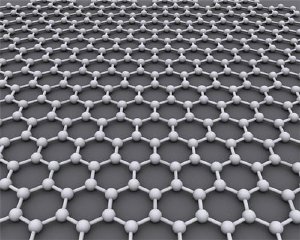Oct 5 2010
The Swedish Nobel Committee has today awarded the Nobel Prize in Physics for 2010 to Andre Geim and Konstantin Novoselov from the University of Manchester, UK, for "two-dimensional material graphene".
The committee announced Geim and Novoselov had shown that carbon in an extremely thin form -- just one atom thick -- had exceptional properties originating in the world of quantum physics.
 Graphene is an atomic-scale honeycomb lattice made of carbon atoms. Photo: Alexander Alus, licensed by Creative Commons Attribution-Share Alike 3.0 MLA style: "Andre Geim - Photo Gallery". Nobelprize.org. 5 Oct 2010
Graphene is an atomic-scale honeycomb lattice made of carbon atoms. Photo: Alexander Alus, licensed by Creative Commons Attribution-Share Alike 3.0 MLA style: "Andre Geim - Photo Gallery". Nobelprize.org. 5 Oct 2010
Graphene is a form of carbon. As a material it is completely new - not only the thinnest ever but also the strongest. As a conductor of electricity it performs as well as copper. As a conductor of heat it outperforms all other known materials. It is almost completely transparent, yet so dense that not even helium, the smallest gas atom, can pass through it. Carbon, the basis of all known life on earth, has surprised us once again.
Geim and Novoselov extracted the graphene from a piece of graphite such as is found in ordinary pencils. Using regular adhesive tape they managed to obtain a flake of carbon with a thickness of just one atom. This at a time when many believed it was impossible for such thin crystalline materials to be stable.
Geim, 51, is a Dutch national while Novoselov, 36, holds British and Russian citizenship. Both are natives of Russia and started their careers in physics there.
Konstantin Novoselov is a Royal Society Research Fellow at the University of Manchester in their Mesoscopic Research Group researching mesoscopic systems and nanostructures.
He has published over 60 peer-refereed research papers, including some in Nature and Science, Nature Materials, Nature Physics, Nature Nanotechnology, Reviews of Modern Physics and Physical Review Letters. He has been awarded the 2008 Europhysics Prize "for discovering and isolating a single free-standing atomic layer of carbon (graphene) and elucidating its remarkable electronic properties."
Andre Geim is a Nobel Prize winning physicist known for the discovery of graphene, the development of gecko tape and demonstrations of diamagnetic levitation.
Geim worked as a research scientist at the Institute for Microelectronics Technology in Chernogolovka and then as a post-doctoral fellow at the University of Nottingham, the University of Bath and the University of Copenhagen before becoming an associate professor at the University of Nijmegen. In 2001 he became a Professor of Physics at the University of Manchester and is Director of the Manchester Centre for Mesoscience and Nanotechnology. Since 2007 he has been an EPSRC Senior Research Fellow. He is also a visiting professor at Radboud University in Nijmegen (The Netherlands since 2010).
Geim holds the titles of Langworthy Professor and Royal Society 2010 Anniversary Research Professor.
Click here to read Dr. Novoselov Nanotechnology Thought Leaders Article on Graphene